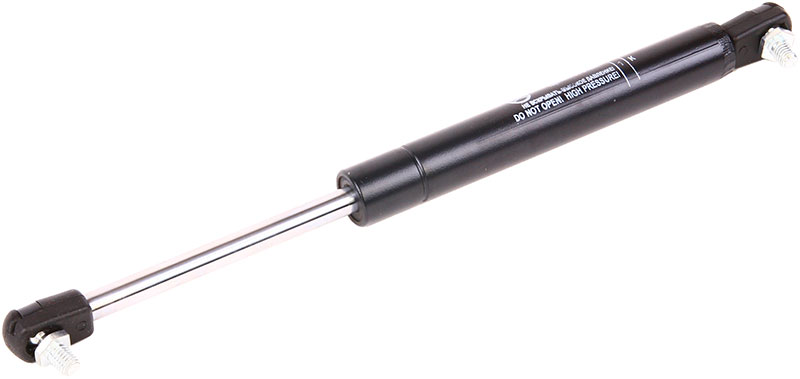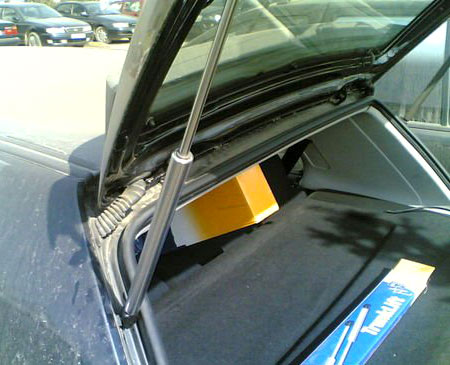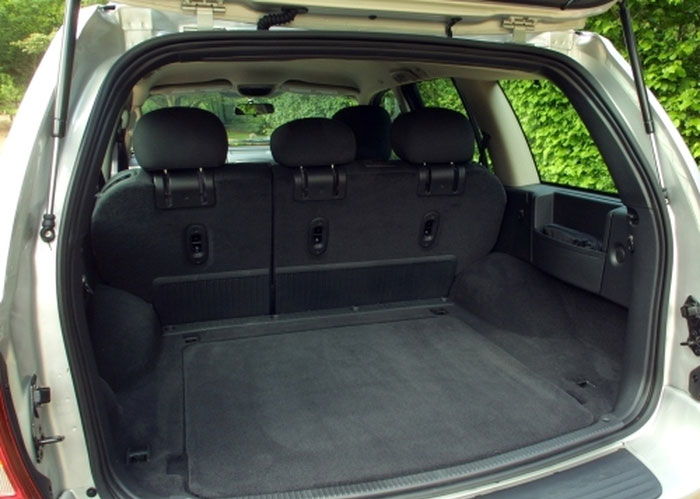
Historically, in cars in the back of a hatchback and station wagon, the tailgate opens upwards. However, in this case, there is a problem of keeping the door open. This problem is successfully solved by gas shock absorbers - read about these parts, their features, maintenance and repair in the article.
Purpose of rear door shock absorbers
Most domestic and foreign cars in the back of a hatchback and station wagon are equipped with a tailgate that opens upwards. This solution is the simplest and most convenient, since you can use the same hinges to open the door up, and the door itself is easier to balance than if it opened sideways. On the other hand, opening the tailgate upwards requires special measures to ensure comfort and safety. First of all, it is necessary to ensure that the door is securely held in the upper position, as well as to help open the door for people of short stature. All these tasks are solved with the help of special shock absorbers of the tailgate.
A tailgate shock absorber (or gas stop) is a pneumatic or hydropneumatic device that solves a number of tasks:
- Assistance in opening the door - the shock absorber automatically raises the door, saving the car owner's energy;
- Damping of shocks and shocks when the rear door is fully opened and closed - the part prevents shocks that occur when the door is raised and lowered to extreme positions;
- Ensuring safety when the door is open - the shock absorber keeps the door in the upper position without the use of additional stops, preventing it from closing under its own weight or weak wind loads;
- Protection of the rear door, sealing elements and structures of the car body from deformation and destruction when the door is closed.
But most importantly, the tailgate shock absorber increases the comfort of the car, as it allows you to easily open and close the trunk even with your hands full, in cold weather, when the car is dirty, etc. Therefore, the tailgate shock absorber is an important component of the car, which makes it more convenient, comfortable and safer.
Types, device and operation of shock absorbers (stops) of the rear door
Currently, two types of tailgate shock absorbers are used:
- Pneumatic (or gas);
- Hydropneumatic (or gas-oil).
These shock absorbers differ in both some design details and features of work:
- Dynamic damping is implemented in pneumatic (gas) shock absorbers;
- In hydropneumatic (gas-oil) shock absorbers, hydraulic damping is implemented.

It is easy to understand the difference between these types of devices, it is enough to disassemble their structure and principle of operation.
Both types of shock absorbers have essentially the same design. They are based on a cylinder filled with nitrogen under a sufficiently high pressure. Inside the cylinder there is a piston rigidly connected to the rod. The rod itself is brought out through the gland assembly - it performs both the functions of lubricating the rod and sealing the cylinder. In the middle part of the cylinder, in its walls, there are gas channels of small cross-section, through which gas from the above-piston space can flow into the piston space and in the opposite direction.
There is nothing else in the gas shock absorber, and in the hydropneumatic shock absorber, on the rod side, there is an oil bath. Also, the piston has some differences - it has valves. It is the presence of oil that provides it with hydraulic damping, which will be discussed below.
The pneumatic shock absorber of the tailgate has a simple principle of operation. When the door is closed, the shock absorber is compressed, and in the chamber above the piston there is the main volume of gas under high pressure. When you open the rear door, the gas pressure is no longer balanced by the lock, it exceeds the weight of the door - as a result, the piston is pushed out, and the door smoothly rises up. When the piston reaches the middle part of the cylinder, a channel opens through which the gas partially flows into the opposite (piston) chamber. The pressure in this chamber increases, so the piston gradually slows down and the speed of opening the door decreases. When the top point is reached, the door stops completely, and the impact is damped by a gas "cushion" that forms under the piston.
To close the door, it must be pulled down by hand - in this case, the piston will reopen the gas channels during its movement, part of the gas will flow into the above-piston space, and when the door is closed further, it will shrink and accumulate the energy necessary for the subsequent opening of the door.
The oil shock absorber works the same way, but when the top point is reached, the piston is immersed in the oil, thereby damping the impact. Also in this shock absorber, the gas flows between the chambers in a slightly different way, but there are no cardinal differences from the pneumatic shock absorber in it.
As already mentioned, the so-called dynamic damping is implemented in pneumatic gas stops. It is expressed by the fact that the speed of opening the door decreases gradually from the very beginning of the piston upward movement, and the door comes to the top point at a low speed. That is, the blow is damped not at the final stage of opening the tailgate, but as if extinguished throughout the entire section of traffic.
Hydraulic damping has a key difference: the impact is damped only at the final section of the door opening by immersing the piston in oil. In this case, the door on the entire section of the path opens at a high and almost the same speed, and is braked only just before reaching the top point.
Design and features of the installation of gas stops for the rear door
Both types of shock absorbers have the same design and layout. They are a cylinder (usually painted black for convenience and easy identification) from which a mirror-polished stem emerges. On the closed end of the cylinder and on the rod, fasteners are made for mounting to the door and body. The shock absorbers are mounted hinged, with the help of ball pins, pressed or otherwise fixed in the appropriate supports at the ends of the shock absorber. Installation of ball pins on the body and door - through holes or special brackets with nuts (threads are provided on the fingers for this).
Shock absorbers, depending on the type, have installation features. Pneumatic-type shock absorbers (gas) can be installed in any position, since orientation in space does not affect their operation. Hydropneumatic shock absorbers can only be installed with the stem down, since the oil must always be above the piston, which ensures the best damping qualities.
Maintenance and repair of tailgate shock absorbers
Rear door shock absorbers do not require any special maintenance during the entire service life. It is only necessary to periodically inspect these parts for their integrity and monitor the appearance of oil smudges (if it is a hydropneumatic shock absorber). If a malfunction is detected and there is a deterioration in the operation of the shock absorber (it does not raise the door well enough, does not dampen shocks, etc.), then it should be replaced in the assembly.
Replacing the shock absorber usually comes down to the following:
1.Raise the tailgate, ensure its retention with an additional stop;
2.Unscrew the two nuts holding the ball pins of the shock absorber, remove the shock absorber;
3.Install a new shock absorber, ensure its correct orientation (stem up or rod down, depending on the type);
4.Tighten the nuts with the recommended force.
To extend the life of shock absorbers and increase their life, you must follow a few simple operating recommendations. In particular, you should not "help" them to raise the door, you should not lift the door with a strong push, as this can lead to breakage. In the cold season, you need to open the tailgate carefully, best of all after warming up the cabin, since the shock absorbers freeze and work somewhat worse. And, of course, it is not allowed to disassemble these parts, throw them into the fire, subject them to strong blows, etc.
With careful operation, the tailgate shock absorber will work for a long time and reliably, making the car more comfortable and convenient in a variety of situations.

Post time: Aug-27-2023
